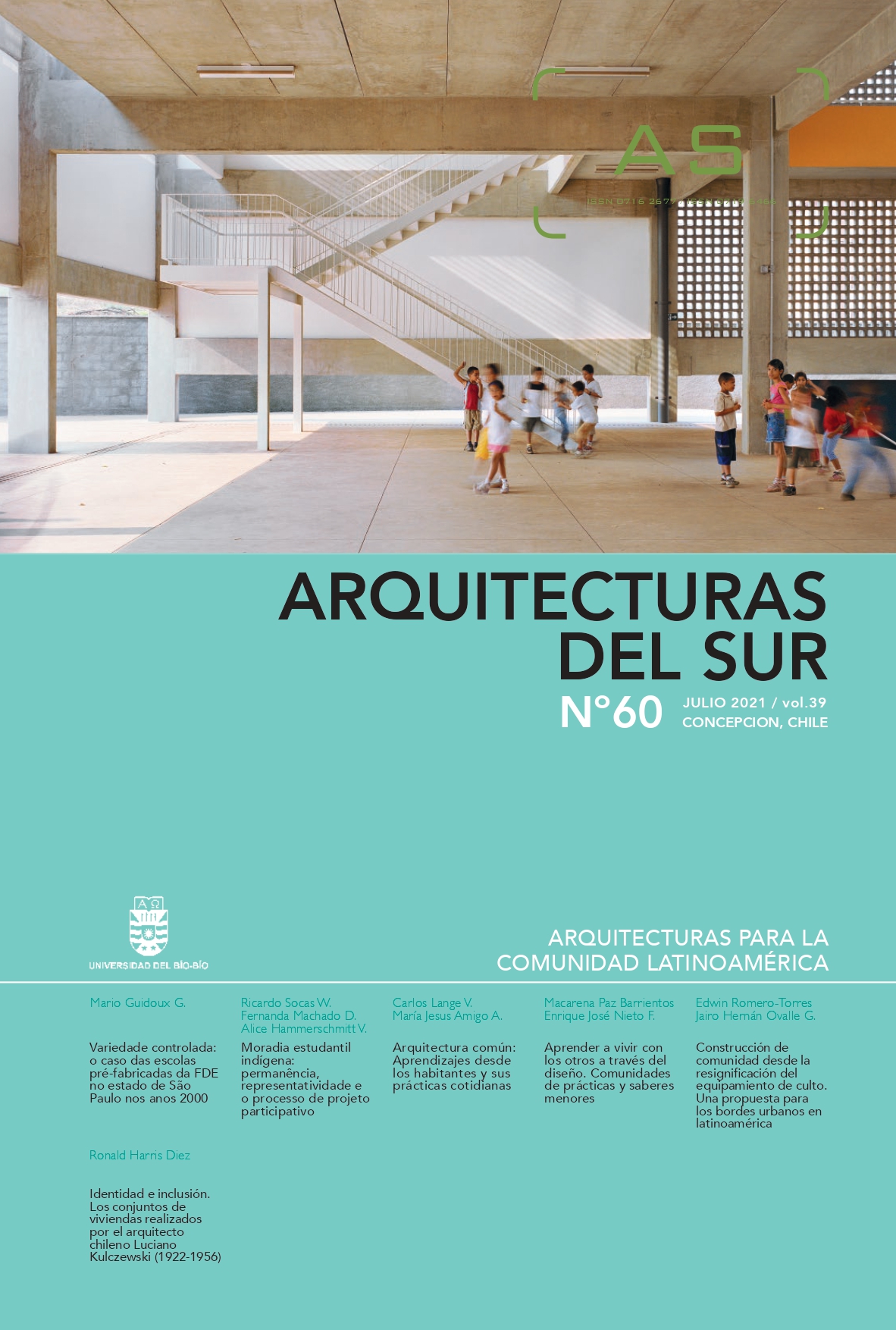Learning to live with others through design. Communities of practices and minor knowledge
DOI:
https://doi.org/10.22320/07196466.2021.39.060.04Keywords:
Project didactics, communities of practices, minor knowledge, pluriversity, critical pedagogiesAbstract
Questioning the ways in which we have understood architectural practice up until today, reconsidering this, is not a just a challenge for professional practices and the materialization of "other works". It is also the responsibility of the educational sphere, in the sense of broadening the way we teach and learn about architecture. Through a recent teaching experience, focused on some "communities of practice", located in the hills of Valparaíso, it is proposed in this article, to imagine a more relational, affective and inclusive future for the area, that perhaps is less "humanistic" and more human or even "much more than human". The wording of the workshop, The good arts of living "with" others "through" design, alluded to design as a set of practices that fundamentally affect our ways of being together, capable of articulating alternative and certainly local ways of living. The aim of the workshop was to make room in the debates on architecture, for those subjects not represented by the most common methodologies and knowledge inherited from Modernity. Faced with them, the course called for a more inclusive and relational type of "minor knowledge", capable of better interpreting the eco-dependent and interdependent condition that characterizes our radical being in the world. Therefore, it sought to problematize the present of architecture from a committed approach of design to these "communities of practice" and their "minor knowledges". Not because they are necessarily better, but because they include a greater quantity and diversity of forms of life.
Downloads
References
AWAN, N., SCHENIDER, T. Y TILL, J. (2011) Spatial Agency: other ways of doing architecture. Londres: Routledge.
BRAIDOTTI, R., (2015) Lo posthumano. Barcelona: Editorial Gedisa.
BRAIDOTTI, R., (2020). El conocimiento posthumano. Traducido por Júlia Ibarz. Barcelona: Editorial Gedisa.
BROWN, S. Y GLASNER, A. (2003). Evaluar en la universidad: problemas y nuevos enfoques. Madrid: Narcea.
CARTA, S. (2016). Transdisciplinarity: A New Generation of Architects and Mediocritas. Enquiry, 13(1), 1-6. DOI: http://dx.doi.org/10.17831/enq:arcc.v13i2.399
FRASER, M. (2005). The cultural context of critical architecture. Journal of Architecture, 10(3), 317-322.
GIROUX, H. (2007). Utopian thinking in dangerous times: Critical pedagogy and the project of educated hope. En Cote, M., Day, R. y de Preuter, G. (Eds.), Utopian pedagogy: Radical experiments against neoliberal globalization (pp. 25-42). University of Toronto Press.
GREENE, M., SCHEERLINCK, K. Y SCHOONJANS, Y. (2012). The new architect. Towards a shared authorship. En Boutsen, D. (Ed.), Good practices best practices. Highlighting the Compound Idea of Education, Creativity, Research and Practice (pp. 17-23). Amberes: Luca.
HERRERO, Y. (2018). La vida en el centro: voces y relatos ecofeministas. Madrid: Libros en Acción.
IBELINGS, H. (2004). Dutch Architecture at the beginning of the 21st Century. Five Ingredients for a Worst Case Scenario. En Constanzo, M. y Ibelings, H. (Eds.), Dutch touch: sulla seconda modernità in Olanda. Roma: Editorial Kappa.
KOCH, A., SCHWENNSEN, K., DUTTON T. Y SMITH, D. (2002). The redesign of studio culture, a repost of the AIAS Studio Task Force. American Studio of Architectural Students. Recuperado de https://www.aias.org/wp-content/uploads/2016/09/The_Redesign_of_Studio_Culture_2002.pdf
MONEDERO, J. (2003). Enseñanza y práctica profesional de la arquitectura en Europa y EEUU. Barcelona: Departament d'Expressió Gràfica Arquitectònica I, ETS d’Arquitectura de Barcelona.
NICULAE, R. (2012). Gender issues in architectural education: feminine paradigm. Review of Applied Socio- Economic Research, 3(1), 144-152.
NIETO, E. (2018). Investigar, sí, pero ¿para qué mundos? En J.J. Vázquez Avellaneda y L. Fernández-Valderrama (Eds.), Colección Investigaciones Idpa_04 (pp. 13-24). Sevilla: RU books.
PÉREZ OYARZÚN, F. (2015). Procesos Formativos: currículum del arquitecto del Siglo XXI. En Foro de la XIX Bienal de Arquitectura + Educación. Valparaíso, Chile, 2015.
PULEO, A. (2013). Ecofeminismo para otro mundo posible. Madrid: Cátedra.
SERRA, M. (2020). La docencia en arquitectura participada: oportunidades más allá de lo inclusivo. En García Escudero, D. y Bardí, B. (Eds.), VII Jornadas sobre Innovación Docente en Arquitectura (JIDA´19). Barcelona: RU Books, UDP UPC.
STENGERS, I. (2005). Introductory notes on an ecology of practices. Cultural Studies Review, 11(1), 183-96. DOI: 10.5130/csr.v11i1.3459
SUSSKIND, R. Y SUSSKIND, D. (2016). El futuro de las profesiones. Cómo la tecnología transformará el trabajo de los expertos humanos. Zaragoza: Editorial TEELL.
TEYMUR, N. (2011). Aprender de la educación en arquitectura. Revista DEARQ., 9, 8-17.
WENGER, E. (1999). Communities of Practice: Learning, Meaning, and Identity. Cambridge: Cambridge University Press.
Downloads
Published
How to Cite
Issue
Section
License
Copyright (c) 2021 Macarena Paz Barrientos-Díaz, Enrique José Nieto-Fernández

This work is licensed under a Creative Commons Attribution-ShareAlike 4.0 International License.
The content of the articles published in each issue of Arquitecturas del Sur is the sole responsibility of the authors and does not necessarily represent the opinion of University of the Bío-Bío.
The authors will maintain their copyright; however, they will guarantee the journal the right to first publication and dissemination of their work. The publication of the article in Arquitecturas del Sur will be subject to the Creative Commons International license (CC BY-SA) that allows others to adapt: remix, transform and build on the material for any purpose, even commercially; share: copy and redistribute the material in any medium or format, as long as the authorship and first publication in this journal are acknowledged by citing them correctly, and their new contributions are under a license with the same terms.














 Programa de Información Científica/Concurso Fondos de Publicación de Revistas Científicas 2018/ Proyecto Mejoramiento de Visibilidad de Revistas UBB (Código:FP180007)
Programa de Información Científica/Concurso Fondos de Publicación de Revistas Científicas 2018/ Proyecto Mejoramiento de Visibilidad de Revistas UBB (Código:FP180007) 
